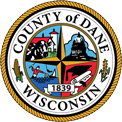

The Dane County Zoning Division is the floodplain administrator for rural portions of the County. Development occurring within the regulatory floodplain must comply with Chapter 17: Floodplain Zoning regulations and requires a floodplain development permit.
Flood insurance rate maps, or FIRMs, are creates by the Federal Emergency Management Agency (FEMA) and the State of Wisconsin Department of Natural Resources (DNR) to assign flood risk categories to properties. The categories used in Dane County are Zones A, AE, and X.
Zone A and AE are zones of high flood risk. Lands within these zones must comply with floodplain zoning regulations. Zone A floodplains do not have a defined base flood elevation, whereas Zone AE floodplains have been studied and the floodplain boundary is defined by a specific elevation. Development occurring within a Zone A or AE floodplain requires a floodplain development permit.
Zone X is an area of lower flood risk. There is still potential that flooding may occur, however development is not subject to floodplain regulation.
FEMA is the official repository for flood insurance rate maps. The FEMA Map Service Center will always be the most current source to obtain floodplain maps. Dane County's interactive mapping service, DCiMap, also contains a floodplain layer and can be used to determine if your property is located in a floodplain.
Floodplain development permits are required for any development occurring within the regulatory floodplain.
Development is defined as any artificial change to improved or unimproved real estate including, but not limited to, the construction of buildings, structures or accessory structures; the construction of additions or alteration to buildings, structures or accessory structures; the repair of any damaged structure or the improvement or renovation of any structure, regardless of percentage of damage or improvement; the placement of buildings or structures; subdivision layout and site preparation; mining, dredging, filling, grading, paving, excavation or drilling operations; the storage, deposition or extraction of materials or equipment; and the installation, repair or removal of public or private sewage disposal systems or water supply facilities.
Permit application materials will need to demonstrate compliance with Chapter 17: Floodplain Zoning regulations.
Questions regarding floodplain regulations or permit applications should be directed to Assistant Zoning Administrator, Hans Hilbert, by e-mail or calling 608-266-4993.
Click for the Floodplain Development Permit ApplicationIf you have experienced flood damage to your residence or other structures, this document explains the steps to follow to ensure compliance with County floodplain regulations. These regulations pertain to homes and other structures that are within the Federal Emergency Management Agency (FEMA) mapped floodplain. Some structures damaged during flood events are not located within the regulatory floodplain and may be subject to other regulations. ?
By using the FEMA Map Service Center, DCiMap, or Contacting Dane County Zoning you can determine if your property is within the FEMA regulatory floodplain. If your property is within the regulatory floodplain the following steps needs to be followed to assure compliance with floodplain regulations:
Site Inspection ⇒ meet rebuilding requirements ⇒ submit documentation ⇒ rebuild ⇒verification
A site inspection by County zoning staff will be conducted of your property. The inspection may have occurred already. The Dane County Zoning Division is required by FEMA to document all damage and repairs made to structures within the regulatory floodplain. The inspector will determine if the damage to the structure is considered substantial. Structures are considered substantially damaged if they are damaged by 50% or more of the structure’s equalized assessed value (EAV) as listed before the damage occurred. EAV for your property can be found on AccessDane or by contacting your town assessor’s office.
The repair to substantially damaged structures will only be permitted if the scope of repair brings the entire structure into compliance with current floodplain regulations. Compliance for residential structures requires: ?
Minor alterations such as changing roof pitches as well as new decks that do not exceed 200 square feet are typically allowed, however there may be other shoreland zoning or general zoning regulations that apply.
The base flood elevation can be found using a FEMA Flood Insurance Rate Map or by contacting Dane County Zoning. In some areas of the County a base flood elevation may not be established and additional engineering work will be required.
Repairs to damaged structures typically require a floodplain development permit and a general zoning permit from the Dane County Zoning Division. Depending on the structures location a shoreland zoning permit may also be required. These permits must be obtained before other agencies, such as Dane County Land and Water Resources (erosion control), and local Towns (building permits) will issue their permits. The following must be submitted to the Dane County Zoning Division for review: ?
In order to begin repairs, the permit applications described in Step 3 must be reviewed and approved by the Dane County Zoning Division. The fees for reviewing the documentation are $125 for a floodplain development permit, and a $50 base fee for a zoning permit. Additional permits and fees may apply. Other agencies, such as Dane County Land and Water Resources, Dane County Environmental Health, and the Town building inspector may have other permits that also need to be obtained. ?
Please follow requirements noted on all permits obtained.
The Dane County Zoning Division is required to document all repairs to buildings constructed or reconstructed within the floodplain and issue a Certificate of Compliance for the building. The Zoning Division will conduct a final inspection to verify that the building has been constructed to the submitted plans, and that necessary information (see below) is filed with the Division. Failure to obtain a Certificate of Compliance will result in legal action or possible condemnation of the building. The following information shall be submitted to the Dane County Zoning Division:
We are here to help. We want to protect you and your property from future flood damage. If you have any questions or concerns regarding your project during this process, please call us for assistance. The Dane County Zoning Division, (608) 266-4266, will strive to work cooperatively to resolve any issues with any step along the way. Your cooperation will be greatly appreciated in this matter.
Respectfully,
Roger W. Lane III
Dane County Zoning Administrator
(608) 266-9078
lane.roger@danecounty.gov
Dane County Zoning does not regulate or require flood insurance, however we strongly encourage property owners to consider obtaining flood insurance regardless of if they are required to or not.
The majority of flood insurance claims made in Dane County are related to structures located outside of the regulatory floodplain. A structure is not required to be located within the regulatory floodplain in order to obtain flood insurance on it.
Additional information on flood insurance can be found on the National Flood Insurance Program webpage.